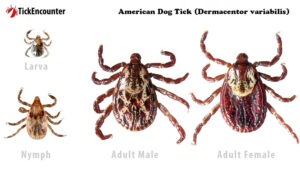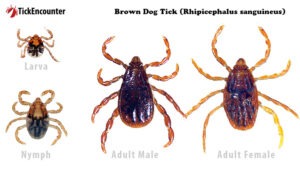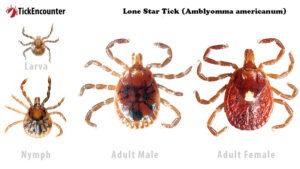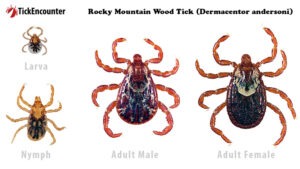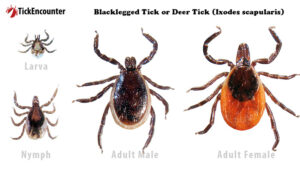-
Adopt
-
Veterinary Care
Services
Client Information
- What to Expect – Angell Boston
- Client Rights and Responsibilities
- Payments / Financial Assistance
- Pharmacy
- Client Policies
- Our Doctors
- Grief Support / Counseling
- Directions and Parking
- Helpful “How-to” Pet Care
Online Payments
Referrals
- Referral Forms/Contact
- Direct Connect
- Referring Veterinarian Portal
- Clinical Articles
- Partners in Care Newsletter
CE, Internships & Alumni Info
CE Seminar Schedule
Emergency: Boston
Emergency: Waltham
Poison Control Hotline
-
Programs & Resources
- Careers
-
Donate Now
A Head-To-Tail Look at Keeping Your Furry Friend Safe
Ah, spring is here! Once the weather starts to warm up and the snow melts, taking your dog for a walk outdoors is one of the best ways to bond and exercise together.
But one thing also returns once winter’s cold subsides: the tick.
During the winter, when the temperatures drop below a certain point, ticks usually go dormant. Once temperatures reach 45 degrees and higher for a few days, ticks will resume their activity and seek hosts.
Ticks do have some benefits. Animals (such as reptiles and birds) eat them, and they provide information on the state of our ecosystems. Small mammals like rodents, squirrels, and rabbits are also likely to be plentiful where ticks are abundant. Having a low tick population can also indicate that predators of smaller animals are out of control.
In general, though, and particularly when it comes to our pets, ticks are the bane of outdoor recreation. Knowing where ticks hide, how to tell them apart, and how to prevent them from using your pet as a host can make springtime romps with your dog less stressful.
Is that a tick? How to know for sure
A dark speck of something appears in your dog’s fur. You immediately scream, “TICK!” But upon closer inspection, you find it’s just dirt. So, how can you tell for sure you see a tick?
Ticks are small, so make sure you scrutinize your dog. The ticks in the larval stage are tiny as a speck of sand. Once the larva molt and become nymphs, they grow to the size of a poppy seed. An adult tick is the size of an apple seed. And if they’ve been feeding on a host? They can grow to the size of a small grape. (You really can’t miss them at this point.)
Below are other ways that help determine whether what you see is a tick:
- There are no wings on ticks
- Ticks are usually flat and oval in appearance (unless they’ve been feeding)
- A tick larva has six legs; a tick nymph or adult has eight legs
- Their colors can range from grayish-white, brown, and black to reddish-brown and yellowish
- A tick can bite in all three of its active life stages: larva, nymph, and adult
What types of ticks affect dogs
There would be a great relief for pet owners if there were only one tick species. The good news? Only a few of the 700 hard ticks and 200 soft ticks found worldwide bite and transmit disease to pets.
American Dog Tick
Locations: East of the U.S. Rocky Mountains and in some areas of the Pacific Coast
Favorite Places: They love open spaces, such as tall grassy fields and low-lying brush and twigs
Appearance: They have dark brown bodies. Females have an off-white shield; males are more mottled in color.
Feeding Times: Adult females do the biting, and their feeding times are during the spring and summer months
Diseases: Canine Ehrlichiosis and Rocky Mountain Spotted Fever
Brown Dog Tick
Locations: Throughout the eastern U.S., as well as areas of the West Coast, they love warm weather, so there are high concentrations of them in the southern regions of the U.S., particularly in Florida
Favorite Places: Anywhere dogs hang out, including kennels, dog beds, and in their humans’ homes. (Fun fact: these critters can spend their entire life indoors.)
Appearance: They are reddish-brown with a narrow shape in comparison to other ticks
Feeding Times: Spring, summer, and fall
Diseases: Rocky Mountain Spotted Fever, Canine Babesiosus, and Canine Ehrlichiosis
Lone Star Tick
Locations: Throughout the Eastern U.S. but most prevalent in the South
Favorite Places: Wooded areas with dense undergrowth and around animal resting areas
Appearance: Reddish-brown; the adult female has a white dot – or “lone star” – on her back
Feeding Times: Notoriously aggressive biters, especially during early spring through late fall
Disease: Canine Ehrlichiosis
Rocky Mountain Wood Ticks
Locations: Rocky Mountain States of Nebraska, South Dakota, Arizona, New Mexico, and California
Favorite Places: They love shrublands, lightly wooded areas, open grasslands, and trails, mainly at lower elevations
Appearance: They look like the American Dog tick but have a bright reddish, teardrop-shaped body (Dog ticks are more dark brown). Females have a white-colored shield, and males will have gray and white spots on their bodies.
Feeding Times: Active between January and November
Diseases: Rocky Mountain Spotted Fever, Colorado Tick Fever
Blacklegged (and Brown) “Deer” Ticks
Locations: Northeastern, Mid-Atlantic, Southeastern, and the North-Central United States but they can extend into Mexico
Favorite Places: A variety of habitats that are suitable for birds, large and small mammals such as mice, deer, squirrels, coyotes, and livestock
Appearance: They have reddish-orange bodies, black shields, and dark black legs
Feeding Times: They search for a host any time when temperatures are above freezing, including during winter
Disease: Transmits Borrelia burgdorferi (the agent of Lyme disease); also Canine Anaplasmosis (referred to as Dog Tick Fever or Dog Fever)
“Deer ticks are, by far, the biggest concern for humans and their dogs – not only because of the diseases they may carry but also because of their small size. It’s easy for them to go unnoticed and attach and transmit diseases,” said Dr. Susan O’Bell, an Internal Medicine specialist at the MSPCA-Angell.
What time of the year are ticks active
Most of the United States experiences an increase in tick activity during the spring. Some species remain active all year (including the winter), but most go dormant. However, during those first few days of warm weather, ticks prepare to feed. Because ticks are cold-blooded, their internal temperature varies according to the temperature of the air. “It doesn’t take much for ticks to become active in slightly warm microclimates,” said Dr. O’Bell. “For this reason, we recommend year-round awareness and prevention, especially for those pets and families living in New England. Unfortunately, there isn’t a start ‒ or end ‒ to tick season here.”
During early spring, people also spend more time outside doing outdoor activities, like hiking and gardening, putting them at even higher risk of encountering a tick. To avoid tick bites, prevention should begin early in the spring.
The tick population decreases as summer ends and the weather cools in the fall. Once the temperature drops below freezing, tick season ends in many parts of the country. While some tick species die in freezing temperatures, others go dormant until they can find food (blood). Ticks that have adapted to colder weather, such as deer ticks, can remain active during the winter.
Some parts of the United States have moderate temperatures, where tick season lasts all year (sort of how parts of New England have turned into). As long as temperatures don’t drop below zero, ticks can still find food in these regions.
Where do ticks like to hide
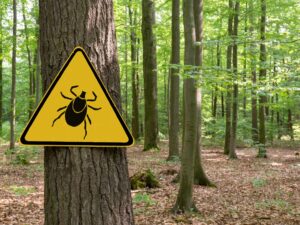
Most ticks live in shady, moist areas near the ground, including under logs, fallen branches, tall brush, and grassy areas. They love to cling to tall grass or low shrubs and then jump off to hunt their next prey. Ticks can also be found around your home on your lawn, garden, and nearby woods and forests.
Ticks are more prevalent in wooded and grassy areas where they feed on woodland creatures, ranging from deer and rabbits to birds and rodents. However, they can also be found in urban areas and on beaches along the coastline.
Here are a few tick habitats where you should keep an eye out for ticks:
- Wood piles (often homes to mice)
- Tall grassy areas
- In the woods
- Piles of leaves and litter/trash
- Branches on the ground
- Overgrown shrubs
- Bird feeders (they encourage other tick-attracting wildlife)
How to spot a tick on your dog
Since ticks are expert hiders, they may be challenging to find if they have hitched a ride on your dog. Keep an eye on the following areas:
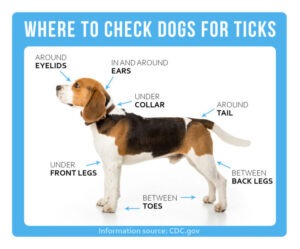 Under the collar
Under the collar
A tick might be able to set up their house under a dog collar since collars are seldom removed. Remove your dog’s collar often and give him a spot check for creepy crawlies.
Private areas
Ticks like to hang out near a dog’s genitals and perianal areas since they are warm.
Inside of ears
Your dog might scratch at its ears because of ticks, and for a good reason: a tick’s favorite spot is inside the ear (lots of tiny places to hide).
Near the eyelids
Is it a stain or a tick? Ticks around the eyes are often challenging to detect, which explains why they go unnoticed often.
Between the toes and around the paw pads
Interestingly, this area goes unchecked sometimes, which makes little sense since dog feet pick up everything outside when they run around. The soft, warm skin around the pads can sometimes attract ticks, so check between each toe and in and around your dog’s paw.
Mouth and lips
There is a chance that if you have a dog who enjoys munching on grass for his daily “salad,” he may end up with more than just grass. Grass can host ticks that attach to the tongue or muzzle of dogs and enter the mouth when they lick their lips. It can be challenging to find ticks attached to the dog’s gums, especially between the teeth.
In most cases, as soon as you find a tick, it will already be attached to your pet and feeding. Still, sometimes you’ll find an unfed tick wandering across the top of your dog’s fur, looking for food.
How to remove a tick from your dog
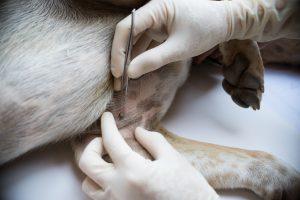
Finding a tick on your dog is often more difficult than removing one. If you know the proper method, you can safely dispose of ticks.
Removal and disposal
Once you find a tick, you need to remove it as soon as possible. Otherwise, you may leave the tick’s head in the skin, which can cause later infections. It is essential to wear rubber gloves to prevent injury or infection whenever you remove a tick.
- Tweezers with fine tips are very effective for removing ticks from the skin.
- Pull the tick’s body slowly away from the dog’s skin. It would be best not to crush the tick because it can spread disease.
- If you’re using a tick removal tool, place the “forked” part under the bug, close to the dog’s skin. Don’t pull it straight out – this can break the tick and leave a piece of it behind in your dog. Instead, turn the tool clockwise several times.
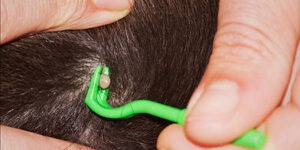
- After you remove the tick, clean your dog’s skin with soap and warm water (or you can dab it with alcohol).
- Drop the tick into a glass jar, plastic bag, or something else that’s sealable. Add rubbing alcohol to the jar. The alcohol will kill the tick. Allow it to remain for a few weeks. If your dog seems ill, take the tick to your vet. They will examine it to see what kind it is, which can let them know whether it caused your pet to become ill.
- Wash your hands with soap and warm water.
In the coming weeks, check the tick bite area often on your dog. If it looks infected or irritated, contact your veterinarian. Be aware if you see your dog excessively tired, have trouble walking, or do not eat or drink what they usually do. If this happens, schedule an appointment with a vet and take the tick with you
How do you prevent your dog from getting ticks
Prevention is the golden rule for keeping your dog free from tick-borne diseases.
Stay away from tall grassy areas
Grassy areas are a tick’s favorite hangout. It would be best to avoid or limit field exposure while walking your dog during tick season (generally the warmer months between March and September). Staying away from tall grassy areas (like fields) is particularly important if deer graze in the area. It’s better to walk in the center of trails or paths, away from plants and bushes along the edges, where ticks like to keep on the lookout for their next meal.
Make it a habit to check your dog regularly
After your walk, it’s good to check your pet thoroughly for ticks that may have jumped on you while you and your dog were outside. Honestly, even if you haven’t been for a walk, it’s still a good idea to check your dog for ticks. It is essential to check the head, ears, legs, and undercarriage as ticks usually latch onto these areas. It’s not uncommon for ticks to hitch a ride on a dog right into the house and then continue living right alongside you and the rest of your family.
Choose the proper tick treatment
“There are many options and applications (topical spot-on products, collars, newer oral chewable tablets),” said Dr. O’Bell. Regardless of the ones you ultimately choose to use, please remember that these treatments are only effective when used regularly and following the manufacturer’s instructions (if you’re using a medication). “Your veterinarian can help you select the safest and most effective products and determine the best dosing intervals,” said Dr. O’Bell.
Always protect yourself!
When walking your dog in tick-prone areas, it’s essential to wear appropriate clothing to avoid picking up ticks yourself, putting your whole family at risk. Wearing light-colored clothing that covers your skin helps prevent tick bites. Never wear shorts; wear long pants and tuck them into your socks to protect your ankles. And when you return from a walk, check for ticks before entering the house.
“Ticks crawl for some time before attaching, so there is a window of time when they can be removed before they could transmit disease,” explained Dr. O’Bell. “Have a friend help you if possible, or use two mirrors, as they often head “north” and could be wandering along your back, back of your neck, behind your ears, and along your hairline.”
What do vets recommend for tick prevention
Topical tick medications
Topical tick medications are placed directly on your dog’s skin. They kill and repel ticks when the tick lands on your dog, so ticks do not need to bite for the medication to work.
Oral tick medications
A tick must bite your pet and feed on its blood to die. This is where oral tick medications come into play: the dog ingests the pill, and that’s it – the medicine moves throughout the dog’s bloodstream. Admittedly, they are easier to administer than topical tick medications. But some owners prefer killing the tick before it even gets the chance to bite their pet.
Tick Collars
Tick collars contain chemicals that offer ongoing protection for your pup rather than being administered by a topical drop on your dog’s skin or via a pill. Some collars emit a type of gas that repels ticks. Others have medication that seeps into the dog’s skin, so the tick is killed before they bite.
Work with your veterinarian to find the proper over-the-counter and prescription medications that work best for your dog. “All dogs are different, so their tick prevention needs will be different, too,” explained Dr. O’Bell. “Here at Angell, we recommend annual screening for tick-borne diseases as part of their overall tick prevention program. This way, we can check how effective the treatments are for the dog.”
Regular prevention is important
There will be times when you won’t see a tick on your dog before it latches onto its skin, so tick prevention needs to be part of your daily routine. It’s recommended to always work with your veterinarian to see what works best for you and your dog. They know your pet’s health and can recommend treatments and products that can help with tick prevention.

References
Terminix, How to Spot a Tick, https://www.terminix.com/ticks/identification/
LymeDisease.org, Type of Ticks, https://www.lymedisease.org/types-of-ticks/
TickSafety.com, Tick Identification, https://ticksafety.com/tick-identification
Westport Veterinary, Tick-Borne Diseases in Dogs: Symptoms, Treatments, and Prevention, https://www.westportveterinary.com/site/blog-westport-vet/2021/01/11/tick-borne-diseases-dogs
Bob Vila, So, Exactly When is Tick Season? Mark Your Calendars, https://www.msn.com/en-us/health/medical/so-exactly-when-is-tick-season-mark-your-calendars/ar-AANt4Rv
Centers for Disease Control, Regions Where Ticks Live, https://www.cdc.gov/ticks/geographic_distribution.html
IGeneX Inc, Know Before You Go: Tick Habitats and Human Contact, https://igenex.com/tick-talk/know-before-you-go-get-the-facts-on-where-ticks-live-and-how-they-hunt-for-hosts/
Advantage Pet Care, How to Spot a Tick on Your Cat or Dog, https://www.advantagepetcare.com.au/au/parasites/ticks/how-spot-tick-your-cat-or-dog/
Vaughan Pest Control Services, Ticks Pest Control – 5 Commons Places Ticks Hide on Dogs, https://www.vaughanpestcontrolservices.ca/ticks-pest-control-extermination-and-fumigation-services-for-vaughan/
My Pet & I, What Does a Tick Look Like? How to Spot a Tick on Your Cat or Dog, https://ca.mypetandi.com/parasites/ticks/what-does-tick-look-how-spot-tick-your-cat-or-dog/
Fetch by WebMD, Pat Patrol: How to Find and Remove Ticks, https://pets.webmd.com/dogs/find-remove-ticks
Dogtopia, How to Tell If Your Dog Has a Tick and What to Do About It, https://www.dogtopia.com/blog/how-to-tell-if-your-dog-has-a-tick-and-what-to-do-about-it/
Mountain Road Animal Hospital, I Found a Tick On My Dog! What Do I Do Now?, https://www.mountainroadvet.com/i-found-a-tick-on-my-dog-what-do-i-do-now-by-dr-chantal-rittwage/
My Pet & I, Tick Prevention for Dogs: 6 Tips to Keep Your Dog Tick Free, https://uk.mypetandi.com/parasites/ticks/tick-prevention-dogs-6-tips-keep-your-dog-tick-free/
Wag, How to Prevent Your Dog From Getting Ticks, https://wagwalking.com/wellness/how-to-prevent-your-dog-from-getting-ticks
Farmers’ Almanac, 7 Natural Ways to Repel Ticks, https://www.farmersalmanac.com/7-natural-tick-remedies-work-27452
AKC Pet Insurance, Natural Flea and Tick Prevention, https://www.akcpetinsurance.com/blog/natural-flea-and-tick-prevention
GoodRx Health, What’s the Best Tick Medication for My Pet, https://www.goodrx.com/pet-health/pets/best-tick-medication
Northwest Animal Hospital, What Tick Prevention Is Best for My Dog?, https://nwveterinarian.com/tick-prevention-best-dog/
